|
Release date: Nov. 10, 2004 "Squishy Materials" Create a Solid Base of Work for Emory Physicist
"Why does mayonnaise act both like a liquid and a solid? What causes shaving cream to flow differently from toothpaste? These types of questions are at the heart of soft condensed matter physics," says Weeks. Weeks studies the fundamental mysteries behind substances that exist at the intersection between solids and liquids. Also known as complex fluids, these include both common window glass as well as "squishy materials," Weeks' preferred term. He hopes to uncover the physics behind how these materials behave and form, a subject that is still puzzles scientists. "It's an area of physics where it's easy to ask interesting questions. We understand, to a degree, air, atoms, crystals, why water freezes, chemical bonds," says Weeks. "But the glass transition – how something moves between liquid and solid -- is all one very big conjecture right now, and it's amazing how little we understand of it." Weeks specifically examines how the microscopic structure of the elements in squishy materials relate to their distinctive, observable properties. "I'm working to understand why a squishy material, like sand or foam, can behave like a solid and a liquid in what is a continual, transitional process," he says. Earlier this year, Weeks was the recipient of a Presidential Early Career Award for Scientists and Engineers, a top honor for the most promising new researchers in the nation within their fields. Weeks' work has attracted the attention of the food, beverage and skin care industries, as well as NASA, which nominated him for the award. In his NASA work, Weeks has designed experiments to test the physics of colloids in space. Colloids are microscopic particles that are dispersed in a fluid and are common to everyday life, such as paint, ink and milk. The purpose of the NASA experiment is to gain a more fundamental understanding of how the properties of the colloids affect the overall behavior of the liquid. Recent experiments by Weeks have involved poking a sample of colloids (in this case, microscopic plastic balls of uniform size) with a small magnetic particle to see how the colloids respond at the microscopic level, and how this relates to the sample's macroscopic properties. He has found preliminary evidence that shows that the magnetic particle causes the colloids to move more closely together, and creates larger disturbances when the sample changes from a liquid to a paste because of this movement. This change from a liquid to a paste may be analogous to the solidification of regular glass, and so these experiments may have implications for our understanding of how glasses form, Weeks says. ###
|
|
||||||||||||
copyright 2001
For more information contact:

